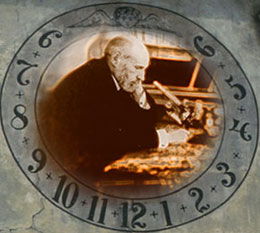|
Santiago Ramón y Cajal was born on March 1st, 1852, in Petilla de Aragon, Spain. His father, Justo Ramon Casasus, a rural doctor, wanted his son to follow in his footsteps. However, Santiago
seemed to be naturally inclined towards drawing. His father made
him study while he, equally stubborn, refused to.
Later on, during his adolescence, Santiago continued to challenge his father’s will: now with dreams of becoming a general, a painter, or a photographer. Fortunately for mankind, when the family moved to Zaragoza, Santiago’s father got him enrolled in college, and Santiago spent long hours studying until in 1873 he received a Bachelor's Degree in medicine. Right after graduating he joined the Military Health Corps in the expeditionary army that left for Cuba in 1874, an adventure from which he returned in 1875, weakened by malaria and dysentery. In Madrid, two years later, he presented doctorate exams and discovered his true scientific vocation: research in the area of histology, or the structure of tissues. He spent whatever money he had saved while in Cuba and bought a second-hand microscope. It was thus he began a career that would lead him to the most amazing discoveries in nervous structures.
In 1878 he obtained his first professor’s chair, and two years later published his first scientific work. He published more and more books and articles while obtaining professor’s chairs in Valencia, Barcelona, and Madrid. Finally his efforts culminated when, in 1888, he succeeded in demonstrating what he had always sustained: the individuality of the nervous cell, the neuron. This discovery alone served as the basis for today’s neurophysiology, one hundred years ahead of its time. Cajal’s work became more and more widespread as new laws and theories were added, all of which were important in the development of neurobiology. He became renowned throughout the world and was awarded prizes and distinctions: honoris causa doctorates in prestigious universities and, among others, the Moscow Prize (1900); the Helmboltz gold medal (1905); and the Nobel Prize for Medicine and Physiology in 1906.
What seemed like a miracle had taken place: a Spanish-speaking scientist, born in a small town, obtained a status reserved for the greatest of mankind. Spain and Latin America paid tributes to Cajal, and his name became immortalized in streets, plazas, and schools. Ever since, the histologist from Aragon has been a lighthouse in the course of Latin science. For decades and even today, Cajal’s majestic drawings continue to illustrate neurology textbooks. His discoveries are of great relevance, and he is one of the most often-quoted authors in specialized bibliographies, along with Einstein and Darwin. In 1934 Santiago Ramon y Cajal died, having been a scientist, researcher, artist, photographer, writer, philosopher and, above all, a humanist. Santiago Ramón y Cajal, an example of the best of the latin spirit. |
|
|
 Can
a problem child become one of the greatest scientists in the world?
Can
a problem child become one of the greatest scientists in the world?